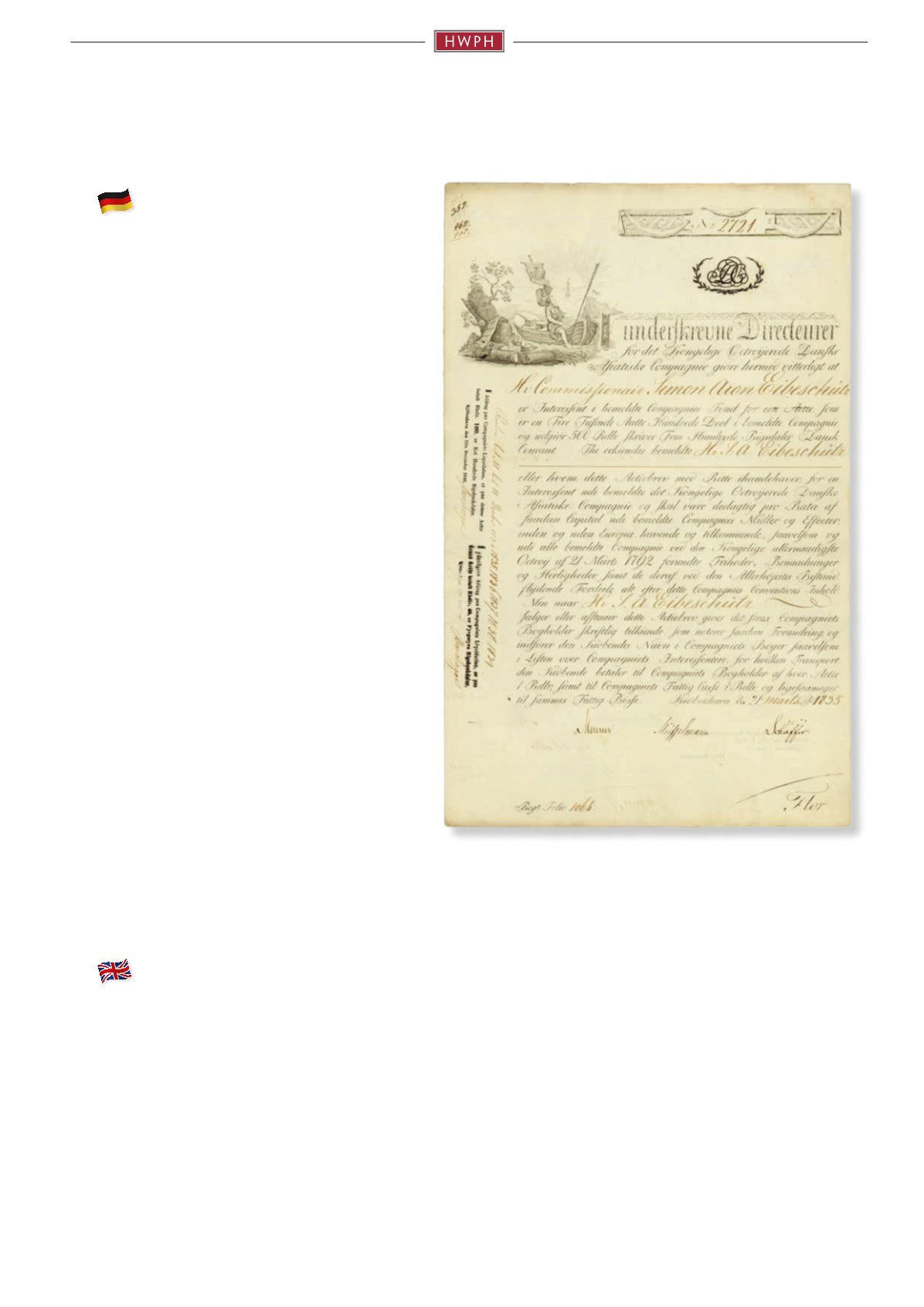

22
Los 602
Kongelige Octroijerede Danske Asiatiske Compagnie
Copenhagen, 21 March 1835, Share of 500 Riksdaler, #2721, 39 x 24.3 cm, black, beige, 4 pages, top edge browned and with
small tears, otherwise EF,
copper engraving with fine vignette and original signatures, rarity!
Although in the 18th century Denmark no longer had the political importance it used to have, the export of the kingdom still continued
to increase strongly. The reasons were Dutch and British subsidies as well as the great wars of this time with the opportunities of high
profits from booms and inflation. The bigger part of the Danish trade was in the hands of the Danish-East Indian Company which was
founded for the first time in 1616 and then again in 1670. When the business collapsed in 1729 due to lack of capital, the king decided
in 1732 to re-establish the company rich in traditions even more splendidly and pompously as the Danish-Asian Company. Particularly
the booming tea trade promised immense profits and so the company, concentrating its activities on India and China, generated net
margins of more than 25 per cent per trading season. Even though the company was depending in its activities to some extent on the
British capital accumulated in Asia, it was also able to prosper during times of war, since British merchants used the neutral Danish flag
as a cover. The main base in India was Traquebar, which had been obtained in 1620. From there the Danes founded further trading of-
fices on the Coromandel coast, in Bengal, Aceh (Sumatra), Bantam (Java), and Macassar (Belebes). The most important commercial
branch, however, was the one in Canton (China). The war economy of 1776 provided a new boom to the company, which by now was
subject to government supervision, so that in 1792 the octroy (privilege) was renewed. As all other overseas trading companies, the Da-
nish-Asian Company also suffered great losses from the Napoleon wars and the trading blockade so that in the beginning of the 19th
century the commercial operations had to be discontinued. In 1845 the business was the last one of all European East India companies
to be liquidated.
Minimum bid: 2,000 €
Kongelige Octroijerede Danske Asiatiske Compagnie
Kopenhagen, 21.03.1835, Aktie über 500 Riksdaler,
#2721, 39 x 24,3 cm, schwarz, beige, DB, Randbräu-
nung und minimale Einrisse oben, sonst EF,
Kupferstich
auf Büttenpapier mit feiner Vignette und Originalunter-
schriften, Rarität!
Obwohl Dänemark im 18. Jahrhundert nicht mehr die poli-
tische Bedeutung wie zuvor hatte, wuchs doch der Außen-
handel des Königreiches sehr stark an. Grund dafür waren
niederländische und englische Subsiden sowie die großen
Kriege dieser Zeit mit den Möglichkeiten hoher Konjunk-
tur- und Inflationsgewinne. Der Großteil des dänischen
Handels lag dabei in der Hand der 1616 zum ersten Mal
und 1670 wieder gegründeten Dänisch-Ostindischen Com-
pagnie. Als das Unternehmen 1729 infolge Kapitalmangels
zusammenbrach, beschloss der König 1732 die traditions-
reiche Gesellschaft noch prächtiger und pompöser als Dä-
nisch-Asiatische Gesellschaft neu zu errichten. Besonders
der boomende Teehandel versprach riesige Gewinne und
so erwirtschaftete die neue Kompagnie, die ihre Aktivitäten
auf Indien und China konzentrierte, Reingewinne von
mehr als 25 Prozent pro Handelssaison. Obwohl die Gesell-
schaft in ihren Aktivitäten weitgehend von dem in Asien
angehäuften englischen Kapital abhängig war, konnte sie
auch in Kriegszeiten prosperieren, weil englische Kaufleute
die neutrale dänische Flagge als Deckmantel benutzten.
Hauptstützpunkt in Indien war das 1620 erworbene Tra-
quebar. Von dort aus gründeten die Dänen weitere Han-
delskontore an der Koromandelküste, in Bengalen, Aceh
(Sumatra), Bentam (Java) und Makassar (Belebes). Die
wichtigste Faktorei war jedoch die von Kanton (China). Die
Kriegskonjunktur von 1776 brachte der Gesellschaft, die in-
zwischen der Staatsaufsicht unterstand, eine neue Blüte, so
dass 1792 das Octroy (Privileg) erneuert wurde. Wie alle an-
deren Überseehandelsgesellschaften entstand auch der Dä-
nisch-Asiatischen Compagnie durch die napoleonischen
Kriege und die Handelsblockade ein schwerer Schaden, so
dass die Geschäfte Anfang des 19. Jahrhunderts eingestellt
werden mussten. 1845 wurde das Unternehmen als letzte
aller europäischen Ostindien-Gesellschaften liquidiert.
Mindestgebot: 2.000 €



















